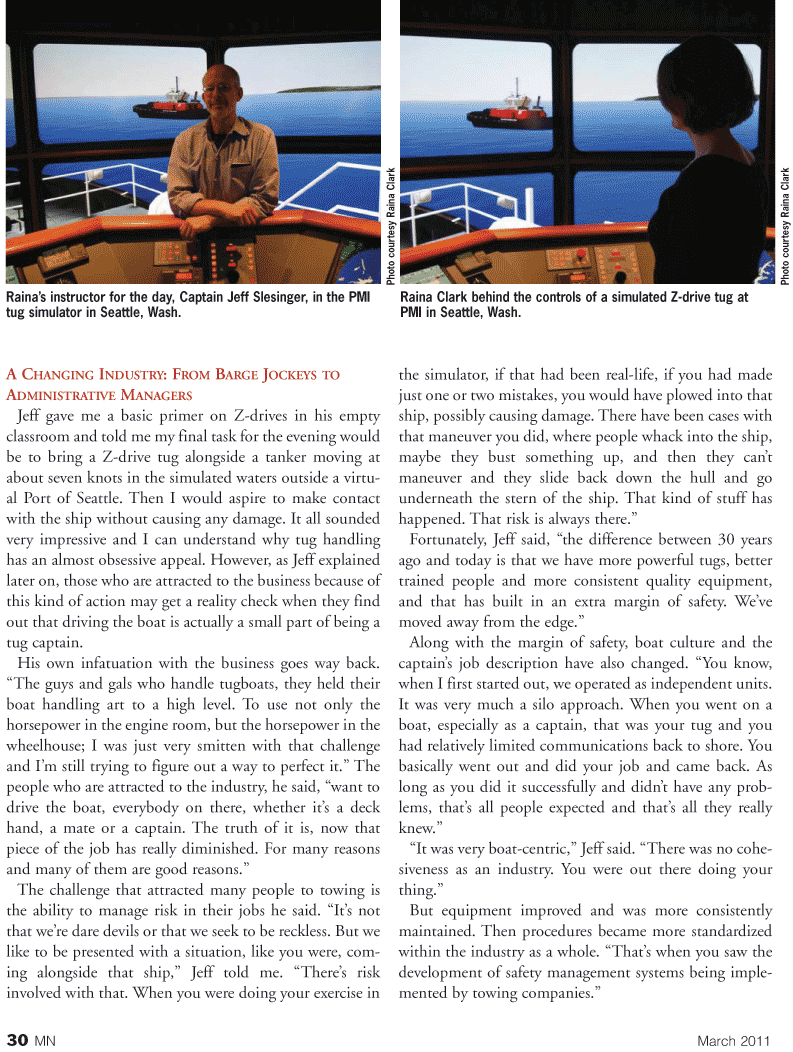
Page 30: of Marine News Magazine (March 2011)
Marine Training & Education Edition
Read this page in Pdf, Flash or Html5 edition of March 2011 Marine News Magazine
30 MN March 2011
A CHANGING INDUSTRY: FROM BARGE JOCKEYS TO
ADMINISTRATIVE MANAGERS
Jeff gave me a basic primer on Z-drives in his empty classroom and told me my final task for the evening would be to bring a Z-drive tug alongside a tanker moving at about seven knots in the simulated waters outside a virtu- al Port of Seattle. Then I would aspire to make contact with the ship without causing any damage. It all sounded very impressive and I can understand why tug handling has an almost obsessive appeal. However, as Jeff explained later on, those who are attracted to the business because of this kind of action may get a reality check when they find out that driving the boat is actually a small part of being a tug captain.
His own infatuation with the business goes way back. “The guys and gals who handle tugboats, they held their boat handling art to a high level. To use not only the horsepower in the engine room, but the horsepower in the wheelhouse; I was just very smitten with that challenge and I’m still trying to figure out a way to perfect it.” The people who are attracted to the industry, he said, “want to drive the boat, everybody on there, whether it’s a deck hand, a mate or a captain. The truth of it is, now that piece of the job has really diminished. For many reasons and many of them are good reasons.”
The challenge that attracted many people to towing is the ability to manage risk in their jobs he said. “It’s not that we’re dare devils or that we seek to be reckless. But we like to be presented with a situation, like you were, com- ing alongside that ship,” Jeff told me. “There’s risk involved with that. When you were doing your exercise in the simulator, if that had been real-life, if you had made just one or two mistakes, you would have plowed into that ship, possibly causing damage. There have been cases with that maneuver you did, where people whack into the ship, maybe they bust something up, and then they can’t maneuver and they slide back down the hull and go underneath the stern of the ship. That kind of stuff has happened. That risk is always there.”
Fortunately, Jeff said, “the difference between 30 years ago and today is that we have more powerful tugs, better trained people and more consistent quality equipment, and that has built in an extra margin of safety. We’ve moved away from the edge.”
Along with the margin of safety, boat culture and the captain’s job description have also changed. “You know, when I first started out, we operated as independent units.
It was very much a silo approach. When you went on a boat, especially as a captain, that was your tug and you had relatively limited communications back to shore. You basically went out and did your job and came back. As long as you did it successfully and didn’t have any prob- lems, that’s all people expected and that’s all they really knew.” “It was very boat-centric,” Jeff said. “There was no cohe- siveness as an industry. You were out there doing your thing.”
But equipment improved and was more consistently maintained. Then procedures became more standardized within the industry as a whole. “That’s when you saw the development of safety management systems being imple- mented by towing companies.”
Raina’s instructor for the day, Captain Jeff Slesinger, in the PMI tug simulator in Seattle, Wash.
Raina Clark behind the controls of a simulated Z-drive tug at
PMI in Seattle, Wash.
Photo cour tesy Raina Clark
Photo cour tesy Raina Clark

 29
29

 31
31
